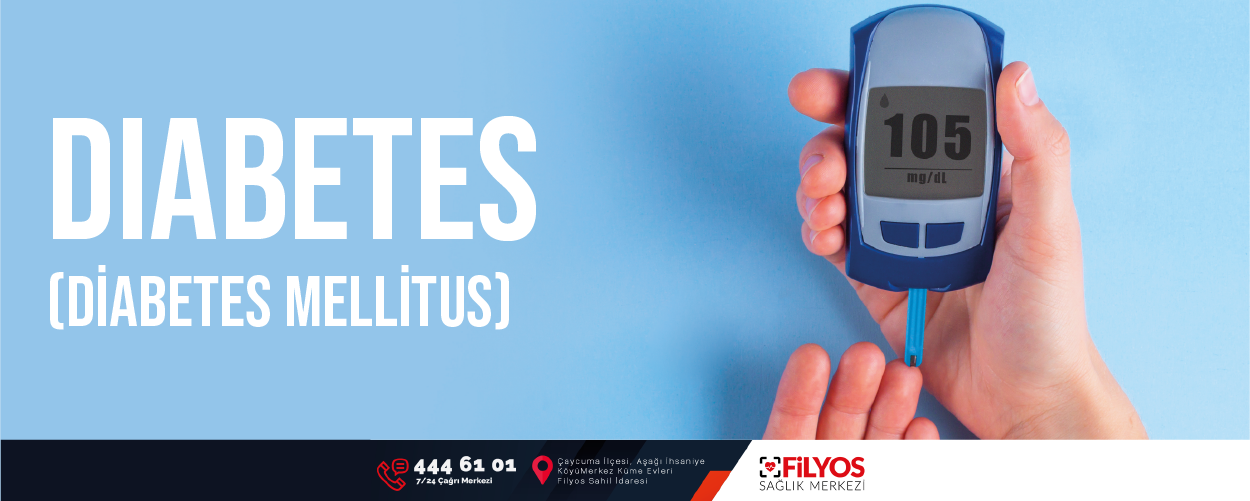
DIABETES (DIABETES MELLITUS)
DEFINITION:
Diabetes is a disease characterized by a disorder of carbohydrate, protein and fat metabolism caused by insufficiency or deficiency of the hormone insulin secreted by the pancreas. It has a chronic, progressive course. It is a condition that requires lifelong medical treatment and medical nutrition therapy. Treatment is as important as diagnosis.
CLASSIFICATION:
-Type 1 DM: It occurs with insulin deficiency as a result of damage to pancreatic cells and is an insulin-dependent progressive type.
-Type 2 DM: It is characterized by insulin resistance and is not insulin dependent.
-Gestational Diabetes: It is the type of diabetes that occurs during pregnancy. It can be diagnosed at 24-28 weeks.
-Other Specific Types: Includes certain genetic syndromes, exocrine pancreatic diseases, endocrinopathies, drug or chemical-associated diabetes.
CLINICAL FINDINGS
GLYCOZURIA (excretion of glucose in urine as a result of hyperglycemia)
Polyuria (increased water output with urine)
POLIDIPSY (constant desire to drink water as a result of dehydration)
POLYPHAGIA (increased feeling of hunger)
TIREDNESS
LATE HEALING OF SKIN WOUNDS
FREQUENT INFECTIONS
BLURRED VISION
COMPLICATIONS:
When the necessary treatment principles are not applied in diabetes patients, blood sugar remains high and may cause complications. For this reason, individuals with diabetes should not neglect their controls.
Diabetic ketoacidosis: Due to insulin deficiency, carbohydrates cannot be used sufficiently and the body starts to provide energy from fats. As a result, ketones are seen in blood and urine. Infection, insufficient insulin treatment, excess carbohydrate intake, eating disorders are among the causes of diabetic ketoacidosis.
Diabetic Nonketotic Hyperosmolar Coma: It is characterized by hyperglycemia (plasma glucose >500 mg/dL) and dehydration without ketoacidosis.
Hypoglycemia: It is characterized by plasma glucose of 50 mg/dL or less. Symptoms include tremor, palpitations, weakness, drowsiness, and difficulty speaking. Hypoglycemia may be caused by skipping meals, failure to follow medical treatment or dose errors, and heavy exercise.
Nephropathy, Retinopathy, Neuropathy, Gastroparesis, Constipation, Atherosclerosis, Diabetic foot
DIAGNOSTIC CRITERIA:
The diagnostic criteria for diabetes for the American Diagnostic Association (ADA) and the World Health Organization (WHO) are as follows:
-Fasting blood glucose level ≥126 mg/dL or
2-hour blood glucose level ≥200 mg/dL in oral blood glucose tolerance test (OGTT) or
-Random blood glucose level ≥200 mg/dL and presence of classic symptoms of diabetes (polyuria, polydipsia, nocturia, enuresis, weight loss, polyphagia) or
-HbA1c > 6.5%
TREATMENT:
Insulin therapy, nutrition and exercise are integral for the treatment of diabetes. Treatment should aim to reduce chronic complications by providing optimal glycemic control.
Studies show that correct and adequate administration of insulin therapy reduces the risk of cardiovascular complications.
In order to reduce the risk of complications from diabetes, smoking should be avoided and blood pressure and cholesterol levels should be kept within appropriate ranges.
Nutrition programs of diabetic patients should be planned individually by a dietician. The person’s height, weight, blood parameters and medications are important data for the program.
SUGGESTIONS:
* Complex carbohydrates with longer digestion should be preferred over simple carbohydrates.
*The nutrition program should be sustainable for a lifetime and should become a lifestyle.
*It should be known that the consumption of legumes, vegetables, fruits, whole grain bread is important.
*Saturated fat consumption should be avoided and healthy fats such as olive oil and butter should be consumed.
*Dough, fried and packaged foods should not be preferred.
*Water consumption should not be neglected during the day, attention should be paid to consume an average of 2-2.5 liters of water per day.
*Exercise is as important as nutrition and medication.
*The nutrition program should include as many meals as the patient needs and should be aimed at maintaining the ideal weight, unless otherwise.
*Posa slows down the absorption of carbohydrates, so foods high in pulp are important in terms of keeping sugar levels under control.
*Foods with high glycemic index should be avoided.
*Foods consumed should be made by grilling, baking, boiling method.
*Omg-3 intake is important, therefore fish consumption is recommended 2 days a week.
*Fat, sugar and salt should be consumed as little as possible.
*Insomnia and stress make it difficult to comply with the diet and may lead to weight gain.
